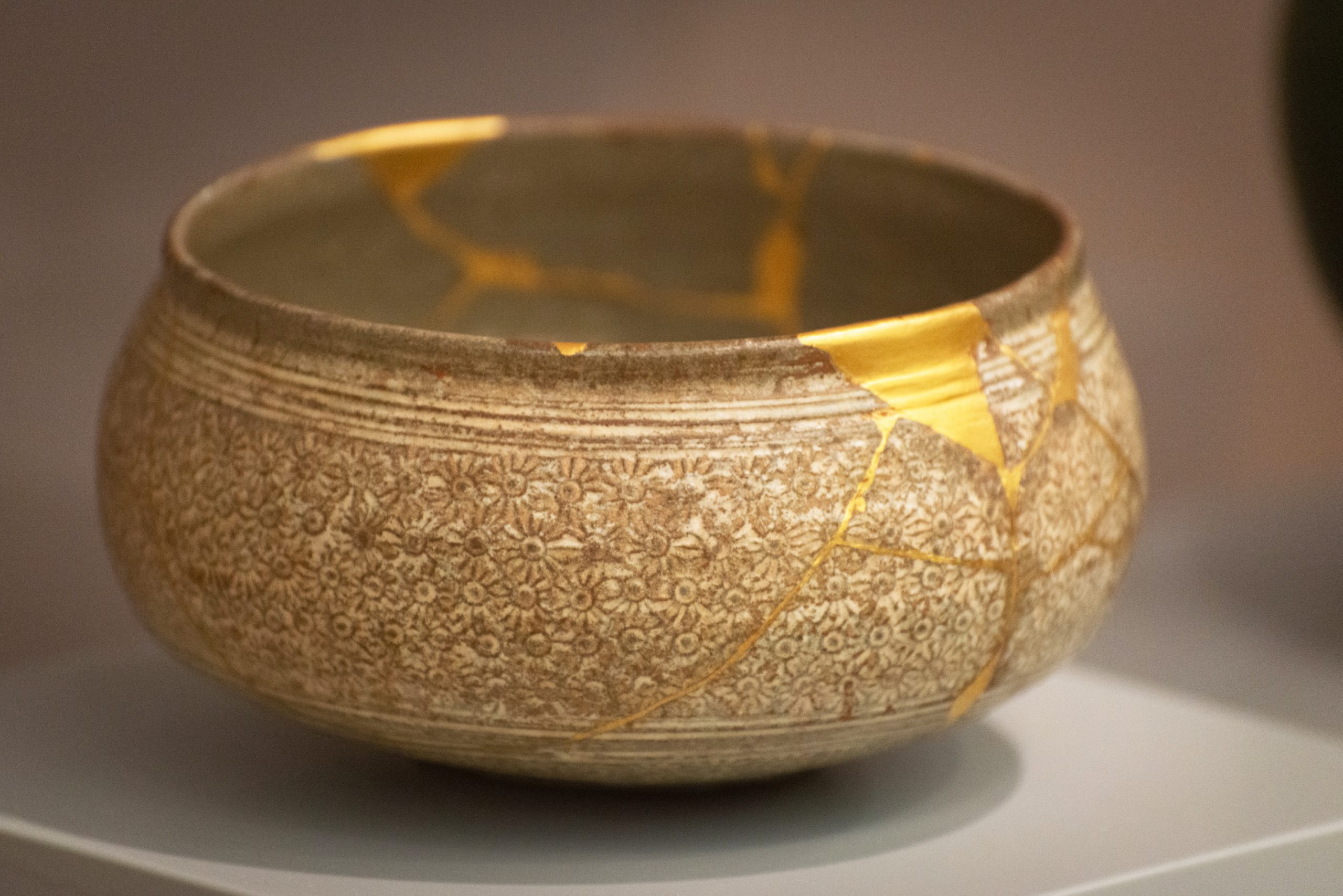
The Columbia Museum of Art houses a piece of pottery repaired using the kintsugi method. This small green-gray bowl, no more than 8 inches in diameter, dates back to 15th or 16th century Korea. Image courtesy of Drew Baron / Columbia Museum of Art
Upon first glance, a broken piece of pottery is useless, seemingly having lost its very purpose of holding tea, flowers, or the admiring gaze of a houseguest. But for a kintsugi artist, this is where the story begins.
Translating to “golden joinery,” kintsugi is an ancient Japanese art form that repairs broken pottery seams with lacquer, which is mixed or dusted with powdered gold, silver, or platinum. The conspicuous repairs not only give the item a second life but highlight its flaws, celebrating them as part of the object’s history.
Kintsugi is part of the Japanese philosophy of wabi-sabi, which emphasizes the beauty of imperfections. May is Asian American and Pacific Islander Heritage Month, and what better way to honor and celebrate the contributions of Asian American creators this spring than to reflect on the legacy of such a meaningful art form that has been passed down for hundreds of years.
Though exact origins of kintsugi are unknown, one story claims it was invented in the 15th century. Legend has it, shogun Ashikaga Yoshimasa accidentally broke his favorite Chinese tea bowl and immediately sent it back to China for repairs. When the bowl was returned, the repair work was shoddy — ugly, even — with visible metal staples holding the broken pieces in place. The Japanese craftsman was inspired to find a better way to repair the bowl, one as elegant as it was structurally sound. From this, kintsugi was born, transforming a broken bowl into an object of beauty.
According to the Smithsonian Institution, records show lacquer has been used to fix broken ceramics across Asia since prehistoric times, though Japanese artists only began using gold to decorate the repairs several centuries ago. The practice likely became more prevalent when it was associated with the tradition of tea in the late 16th century. The golden repairs quickly became an integral part of the appearance of beloved, everyday tea bowls in homes across Japan and now the globe, with many modern artists replicating and building on the method.
The Smithsonian Institution’s Freer Gallery of Art in Washington, D.C., is home to a 17th century tea bowl repaired with the kintsugi method. The small, stoneware bowl’s exterior is delicately punctuated by a luxuriously golden web of lacquer, which in this case comes from a natural resin made from tree sap. According to The Smithsonian, the sap is related to poison ivy and can be toxic when in liquid form. Once the piece is cured however, it is harmless. Using lacquer for pottery repair can be quite a time-consuming process, but once set, it is water resistant and durable.
The Columbia Museum of Art also houses a piece of pottery repaired using the kintsugi method. In Gallery 8, a small green-gray bowl, no more than 8 inches in diameter, sits in understated beauty, a swirl of gold on its exterior catching the eye of many passersby. According to Glenna Barlow, the CMA’s curator of education, the bowl dates back to 15th or 16th century Korea.
“We don’t know the name of the piece or the name of the artist, in part because this item was likely used in everyday life,” Glenna says. “That’s part of the reason it was broken and has this type of repair; it points to fact it was probably used, not just sitting on a shelf somewhere.”
Due to its Korean origins, Glenna estimates the piece was either imported or traded to Japan, or even stolen during Japanese raids on Korea. It was likely used in Japanese tea ceremonies, where it possibly shattered and was repaired by a Japanese potter. For Glenna, the kintsugi bowl’s history is emblematic of the stories of so many works of art that have lived in the museum for decades.
“Many of the pieces have existed for centuries in other places halfway around the world, used in rituals or in everyday functions, and over their long lives, somehow they made their way to Columbia,” she says. “It really is quite remarkable when you think about it.”
Repair Your Pieces Using Kintsugi
Kintsugi repair kits are available for purchase online, and some artisans will expertly repair your broken pieces for a fee. For a beginner’s guide to DIY kintsugi, follow these five simple steps:
Step 1: Pour epoxy on a clean surface and use a mixing stick to add gold powder for color.
Step 2: Once homogenous, use a mixing stick to liberally apply to your broken edge.
Step 3: Wait a few seconds for the epoxy to become tacky. Then hold the broken pieces together for a minute or two.
Step 4: Go in with gold powder on a brush to touch up gold as desired.
Step 5: Repeat steps 1 through 4 as needed.










